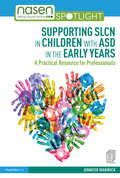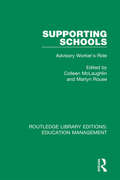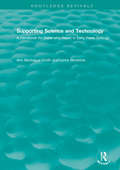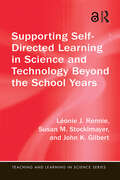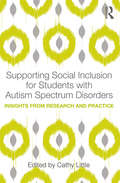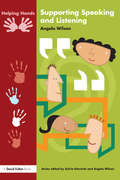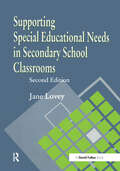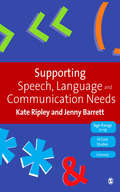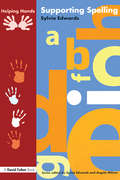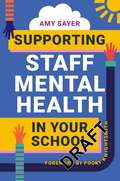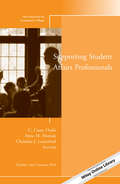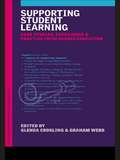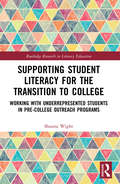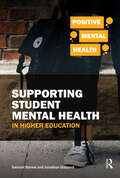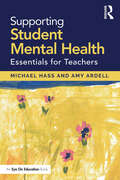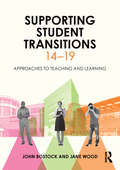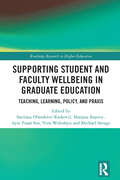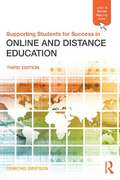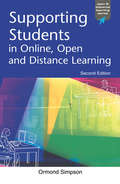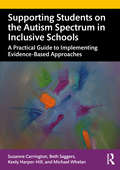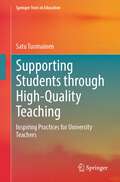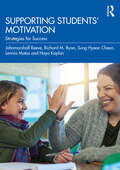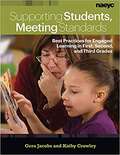- Table View
- List View
Supporting SLCN in Children with ASD in the Early Years: A Practical Resource for Professionals (nasen spotlight)
by Jennifer WarwickWith growing numbers of children with autism spectrum disorder (ASD) being diagnosed in the early years, it is becoming increasingly important for education and health professionals to understand ASD and to implement supportive strategies as part of the everyday curriculum and routine. This book serves as an essential tool kit for anyone working with young children with ASD and speech, language, and communication needs (SLCN). Filled with practical and up-to-date tips, advice, and guidance, it shifts the responsibility of change from the child onto the caregiver, asking the question: what can we do to support the child? Key features of this book include the following: An introduction to ASD Detailed case studies illustrating the varied impacts ASD can have on the life of a child Practical activities and resources, including planning sheets and activity suggestions Easy-to-follow chapters focusing on the classroom environment, communication, social interaction, play, and behaviour Comprehensive, practical, and evidence based, this manual is essential reading for anyone working with children experiencing social communication difficulties and ASD in an early years setting.
Supporting Schools: Advisory Worker's Role (Routledge Library Editions: Education Management)
by Martyn Rouse Colleen McLaughlinOriginally published in 1991. This edited work consists of contributions from practitioners in the field of school improvement, development and advisory work. It is to help advisory and support personnel understand the process of school improvement and to explore the management and development of this work in the context of changes brought about by legislation. The book is for those who are concerned with developing the educational experiences for all children through improving schools. This includes teachers and all those with advisory roles: inspectors, advisers, advisory teachers, educational psychologists, curriculum development officers and external consultants.
Supporting Science and Technology: A Handbook for those who Assist in Early Years Settings (Routledge Revivals)
by Ann Montague-Smith Lorna WinstonePublished in 1998. The Desirable Outcomes for pre-fives and the National Curriculum for Key Stage 1 set out the requirements for learning from nursery through to the end of Key Stage 1 in both science and technology. This book will increase the confidence of the classroom assistants by offering suggestions for improving their subject knowledge in line with these requirements, and advice on how to support the teacher and the child through appropriate learning activities. The handbook will also benefit headteachers and teachers in early years settings who are training volunteers or classroom assistants (perhaps taking STA, BTEC or NNEB courses).
Supporting Self-Directed Learning in Science and Technology Beyond the School Years: Beyond the School Years (Teaching and Learning in Science Series)
by John K. Gilbert Léonie J. Rennie Susan M. StocklmayerWhile much has been written about science education from pre-K through to postgraduate study, interaction with science and technology does not stop when schooling ends. Moving beyond scholarship on conventional education, this book extends the research and provides an original in-depth look at adult and lifelong learning in science and technology. By identifying the knowledge and skills that individuals need to engage in self-directed learning, the book highlights how educators can best support adult learners beyond the years of formal schooling. Through case studies and empirical analysis, the authors offer a research-based exploration of adults’ self-directed learning and provide tools to support adults’ learning experiences in a wide range of environments while being inclusive of all educational backgrounds.
Supporting Social Inclusion for Students with Autism Spectrum Disorders: Insights from Research and Practice
by Cathy LittleDrawing together contributions from experts at the forefront of research in the field, Supporting Social Inclusion for Students with Autism Spectrum Disorders demonstrates that social inclusion is a defining feature of successful education of students with a spectrum disorder. Divided into three parts, this book begins by proposing a contemporary and operational definition of social inclusion that will help facilitate active engagement by all stakeholders involved in supporting social inclusion within educational settings. The relationship between well-developed social skills and positive social outcomes is also explored, and subsequent chapters explicate and contextualize social inclusion across a range of educational settings. The final chapters present case studies and viewpoints from stakeholders central to the successful social inclusion of students with the disorder. Through discussion of its findings, this book provides the reader with a deep understanding of social inclusion and confirms its importance in facilitating positive educational outcomes for students with Autism Spectrum Disorder. A unique contribution to the field, this book will be of key interest to postgraduates, researchers and academics in the area of inclusive education and Autism Spectrum Disorder. It will also appeal to those who research, study and work in the areas of special and inclusive education, and developmental psychology.
Supporting Speaking and Listening (Helping Hands)
by Angela WilsonAngela Wilson focuses on enhancing the speaking and listening skills of the pupils whom you support, analyzing how you can develop their skills, offering advise and guidance on a variety of learning styles and a breakdown of main principles of speaking and listening.
Supporting Special Educational Needs in Secondary School Classrooms
by Jane LoveyTeachers and support teachers in secondary schools can use this book to maximize the impact and effectiveness of their work together. The author looks at a broad range of special needs and offers support strategies that work in a mainstream classroom. Informed by the latest research and updated in the light of the new revised Code of Practice, this new edition explains students' difficulties and contains advice on good classroom practice. It will help the reader to support any student with special educational needs. Teachers, Teaching Assistants and SENCOs will find this book particularly helpful. For specialist study, there is a list of further reading at the end of each chapter. SEN governors in schools will also find this a useful overview of the breadth of special needs for which their school could be expected to cater.
Supporting Speech, Language & Communication Needs: Working with Students Aged 11 to 19
by Jenny Barrett Kate RipleyDesigned for all those who support older children and young adults with speech and language difficulties, this resource provides ideas, practical strategies and detailed information about the speech, language and communication needs (SLCN) of older students. Both authors have over 20 years experience of delivering courses to teachers, Special Needs Co-ordinators (SENCOs) and Specialist Outreach teachers in different local authorities, further education colleges and university departments. Kate Ripley is an Educational Psychologist, trainer and national and international conference speaker on themes related to speech, language and communication needs. Jenny Barrett is a Speech and Language Therapist with internationally recognised expertise in her field, who now works as a freelance consultant.
Supporting Spelling (Helping Hands)
by Sylvia EdwardsSylvia Edwards' book concentrates on enhancing the spelling skills of the pupils whom you support; analyzing how you can develop their spelling skills, offering advise and guidance on a variety of learning styles, and a breakdown of spelling principles.
Supporting Staff Mental Health in Your School
by Amy SayerThis is an accessible guide for schools explaining how to implement effective techniques to improve staff mental health. Drawing on case studies from years of experience supporting staff mental health, Amy Sayer introduces inexpensive, practical and realistic strategies that schools can implement to ensure the mental wellbeing of teaching staff.This book provides steps to ensure that self-care and family time do not slip under the radar in the face of increasing pressure and limited resources. From providing adequate staff room facilities to ensuring that teachers can set clear boundaries around weekends and break times, these ideas create and foster a culture of openness around mental health and help teachers to re-discover their love of teaching.
Supporting Student Affairs Professionals: New Directions for Community Colleges, Number 166 (J-B CC Single Issue Community Colleges)
by C. Casey Ozaki Anne M. Hornak Christina J. LuncefordStudent affairs and services play a critical role in student learning and success, as well as the level at which community colleges meet institutional outcomes. The evolution of student affairs as a field and recognition of its role in student experiences underscore its importance in the effort to provide qualityeducation to college students. This volume provides a framework for excellence in student affairs work at community colleges, including assessing quality and outcomes for program development and accreditation. The authors explore: Excellence in preparing and developing professionals at multiple stages in their careers Creating and using professional standards and competencies Understanding the role of accreditation in professional practice. The issue also includes a discussion of implications for community college student affairs preparation and practice.This is the 166th volume of this Jossey-Bass quarterly report series. Essential to the professional libraries of presidents, vice presidents, deans, and other leaders in today's open-door institutions, New Directions for Community Colleges provides expert guidance in meeting the challenges of their distinctive and expanding educational mission.
Supporting Student Diversity in Higher Education: A practical guide
by Michelle MorganSupporting Student Diversity in Higher Education is a working manual that is designed to help managers, academics and members of the professional service teams within universities, recruit and support a diverse student body across the student lifecycle at the same time as delivering a quality student experience in a challenging and pressured enviro
Supporting Student Learning: Case Studies, Experience and Practice from Higher Education (Case Studies Of Teaching In Higher Education)
by Graham Webb Glenda CroslingThis volume focuses on the support programmes that all higher education establishments have in place to aid and develop student learning. The work is designed to equip HE professionals with an accessible guide to some of the best practices in this field from around the world.
Supporting Student Literacy for the Transition to College: Working with Underrepresented Students in Pre-College Outreach Programs (Routledge Research in Literacy Education)
by Shauna WightFocusing on the needs and experiences of underrepresented students in the US, this text explores how pre-college outreach programs can effectively support the development of students’ writing skills in preparation for the transition from high school to college. Synthesizing data from a longitudinal study focusing on multilingual, low-income, and first-generation students, this volume provides in-depth exploration of the strategies and resources used in a pre-college literacy program in the US. Grounded in an expansive, qualitative study, chapters reveal how outreach practices can encourage student-led research, writing, confidence, and collaboration. More broadly, programs are shown to help tackle issues of inequality, increase college readiness, and reduce difficulties with writing which can restrict minority students’ access to higher education and their longer-term college attainment. This text will benefit researchers, academics, and educators with an interest in English and literacy studies, multicultural education, and pre-college writing instruction. Those interested in bilingualism, translingualism, writing studies, English as a second language (ESL), and applied linguistics will also benefit from the volume.
Supporting Student Mental Health in Higher Education
by Jonathan Glazzard Samuel StonesStudent mental health is a key consideration in higher education at the moment with recent reports identifying a major gap in provision by universities and how ill-equipped academics feel to support students. This book addresses these concerns, providing comprehensive guidance and workable evidence-informed strategies and interventions to help those working with students to support them effectively. It is suitable for lecturers, personal tutors, student counsellors, course leaders, heads of department and administration staff with responsibility for student support.
Supporting Student Mental Health: Essentials for Teachers
by Michael Hass Amy ArdellSupporting Student Mental Health is a guide to the basics of identifying and supporting students with mental health challenges. It’s no secret that your responsibilities as a teacher go beyond academic achievement. You cover key socioemotional competencies in your classrooms, too. This book is full of accessible and appropriate strategies for responding to students’ mental health needs, such as relationship-building, behavioral observation, questioning techniques, community resources, and more. The authors’ public health, prevention science, and restorative practice perspectives will leave you ready to run a classroom that meets the needs of the whole child while ensuring your own well-being on the job.
Supporting Student Transitions 14–19: Approaches to teaching and learning
by Jane Wood John BostockSupporting Student Transitions 14-19 offers transition focused approaches to planning, teaching, learning and assessment designed to meet the needs of these unique learners. Drawing upon the latest research and theory, as well as the authors’ extensive experience in the field, it examines in detail transitions in teaching and learning in this complex sector. Drawing out and critically analysing the key features of both pedagogy and andragogy, the book presents the best elements of each to provide all tutors and practitioners involved in the teaching of 14-19 learners with clear strategies for supporting this group. Practical advice backed by sound theory will provide readers with a clear understanding of the requirements and needs of learners in the school, college and university. Topics explored include: ???? The role of the teacher in supporting student transitions ???? Understanding transition focused approaches Emotional and social factors involved ????Recognising difficulties and helping students prepare Supporting Student Transitions 14-19 is a practical guide also offering a unique contribution to the discourse on this important sector of education, increasingly afforded the attention it deserves. It will be an essential resource for trainee teachers, students of PCET, lecturers and teachers wanting to build upon their understanding of this group of learners.
Supporting Student and Faculty Wellbeing in Graduate Education: Teaching, Learning, Policy, and Praxis (Routledge Research in Higher Education)
by Michael Savage Mirjana Bajovic Ayse Pinar Sen Vera Woloshyn Snežana Obradović-RatkovićSupporting Student and Faculty Wellbeing in Graduate Education recognizes new pressures impacting graduate students and their supervisors, teachers, and mentors globally. The work provides a range of insights and strategies which reflect on wellbeing as an integral part of teaching, learning, policy, and student-mentor relationships. The authors offer a uniquely holistic approach to supporting the wellbeing of both students and academic staff in graduate education. The text showcases optimized approaches to self-care, self-regulation, and policy development, as well as trauma-informed, arts-based, and embodied pedagogies. Particular attention is given to the challenges faced by minority groups including Indigenous, international, refugee, and immigrant students and staff. Providing a timely analysis of the current issues surrounding student and faculty wellbeing, this volume will appeal to scholars and researchers working across the fields of higher education, sociology of education, educational psychology, and student affairs.
Supporting Students for Success in Online and Distance Education: Third Edition
by Ormond SimpsonSupporting Students for Success in Online and Distance Learning, Third Edition, provides a comprehensive overview of student support both on and off campus. While online and distance learning are the world’s fastest growing areas of educational development, they have a fundamental weakness—their graduation rates, which can be lower than 20 percent. In this powerful new edition, Ormond Simpson builds on a rich history of research in distance and e-learning to show how retention rates can be improved through tested support methods, often at a net financial profit to the institutions involved. By comparing the evidence as well as the cost-effectiveness of various support tactics, this book describes how to promote student success and encourage skill-development from a number of different perspectives: definitions and purpose, theory and psychology, ethics, costs and benefits, activities, sources, media, proactive and reactive, assessment and feedback, staff development, writing support into course materials, research, quality assurance and institutional structures. This concise, practical guide is informal and jargon-free, yet its approach to evidence is rigorous, making it invaluable reading for all those interested in recruiting and teaching diverse students for successful online and distance learning.
Supporting Students in Online Open and Distance Learning (Open and Flexible Learning Series)
by Ormond SimpsonThis new addition to the respected Open and Distance Learning Series is an up-to-the-minute guide for educators wanting to come to terms with their support role in open and distance learning. Covering all aspects of student support from tuition and counselling through to the broad range of delivery methods available, the book offers practical solutions that are set within a sound theoretical framework.
Supporting Students in Online, Open and Distance Learning (Open and Flexible Learning Series)
by Ormond SimpsonRecognized as the leading book on the subject, Supporting Students in Online, Open and Distance Learning considers the support of students either on or off-campus. Ever-greater numbers of students are studying as part of open, flexible, distance or online courses and, with the rise in numbers and expectations, so the need to offer these often-diverse students effective support is critical.Fully revised and expanded, this new edition reflects current concerns and developments in ODL. It includes increased coverage of tuition in different media, issues of student retention, structures and quality assurance, staff development, online support and computer conferencing. Practical and authoritative, the book tackles the full range of student support issues in ODL, including:*developing the most appropriate tuition techniques*social support*retention*delivering support at a distance and online*face-to-face support*learning-skills and staff developmentSupporting Students in Online, Open and Distance Learning is essential reading for all those with an interest in recruiting and teaching students in open and distance learning or e-learning situations. It will help lecturers, moderators and tutors to develop a range of skills with a focus on support, retention and student outcomes.
Supporting Students on the Autism Spectrum in Inclusive Schools: A Practical Guide to Implementing Evidence-Based Approaches
by Michael Whelan Keely Harper-Hill Suzanne Carrington Beth SaggersInclusive education has grown as an international movement to not only support students with disabilities but also promote equitable access, participation, and success for all students. This book will transform the capacity of teachers and specialists working with students and families to effectively support an inclusive approach to education for students on the autism spectrum. This book addresses the urgent need to identify inclusive educational environments and strategies for students on the autism spectrum so that they have the best chance of social, behavioural, and academic success at school. Teachers who include students on the autism spectrum in primary and secondary classrooms require greater knowledge of how they can best support the learning, social, and behavioural needs of their students. Without such knowledge, the consequences can include unsatisfactory learning experiences for all students, and interrupted schooling for the student on the autism spectrum through reduced attendance and retention, lower academic performance, exclusion, disengagement, and pressure on parents to make alternative arrangements for their child’s education. Inclusive education is socially, emotionally, and academically beneficial for all students and positively impacts on respectful attitudes to difference. This book presents innovative, evidence-based practices that will build the capacity of teachers and specialists implementing an inclusive and contextually relevant approach to education that will support students on the autism spectrum and meet the diverse needs of all students in their classrooms.
Supporting Students through High-Quality Teaching: Inspiring Practices for University Teachers (Springer Texts in Education)
by Satu TuomainenThis book provides a Finnish perspective on high-quality teaching in higher education and explores Finnish approaches on teaching, learning and supporting students. It addresses the concepts of quality in teaching, teaching excellence and effective teaching in today’s higher education in which the student body has become increasingly international and heterogenous. The book discusses how the role of the teacher has changed from authority to facilitator in the past decades while many students still value their university experience based on the teachers they encounter. The book provides a practitioner view on how students can be supported through communication, compassion and expertise and how professional and pedagogical development are essential for high-quality teaching in an increasingly competitive, diverse and online world of higher education. The book introduces the principles of Finnish higher education and universities, and the Finnish education system in connection with the approach to teaching, teacher education and the highly valued profession of a teacher. What is good teaching in higher education? It can consist of the learning environment, the location, the students and the teacher, and many studies show that effective, compassionate, skilled and humanist teachers will leave their mark on students. It is also equally important for teachers to invest in pedagogical training and conduct research on teaching practices, experiments and students’ perceptions as part of professional development. International classrooms also require specific considerations, as does online learning. The COVID-19 pandemic forced a substantial transfer to online and blended learning in higher education, but can quality teaching exist online, or have we passed the baton to students to be in charge of their learning, to study even more independently?
Supporting Students' Motivation: Strategies for Success
by Richard M. Ryan Johnmarshall Reeve Sung Hyeon Cheon Lennia Matos Haya KaplanThis is a book about teachers’ classroom motivating styles. Motivating style is the interpersonal tone and face-to-face behavior the teacher relies on when trying to motivate students to engage in classroom activities and procedures. The over-arching goal of the book is to help teachers work through the professional developmental process to learn how to provide instruction in ways that students will find to be motivationally-enriching, satisfying, and engagement-generating. To realize this goal, the book features six parts: Part 1: Introduction, introduces what teachers are to support—namely, student motivation; Part 2: Motivating Style, explains what a supportive motivating style is; Part 3: “How to,” overviews the recommended motivationally-supportive instructional strategies one-by-one and step-by-step; Part 4: Workshop, walks the reader through the skill-building workshop experience; Part 5: Benefits, details all the student, teacher, and classroom benefits that come from an improved motivating style; and Part 6: Getting Started, discussesways to begin using these skills in the classroom. Based on a successful workshop program run by the authors, teachers successfully improve their classroom motivating style. In doing so, they experience gains in their teaching skill and efficacy, job satisfaction, a renewed passion for teaching, and a more satisfying relationship with their students. This multiauthored book provides teachers with the practical, concrete, step-by-step, skill-based "how to" they need to develop a highly supportive motivating style.
Supporting Students, Meeting Standards: Best Practices For Engaged Learning In First, Second, And Third Grades
by Gera Jacobs Kathy CrowleyTeaching Enthusiastic, Independent Learners This resource for f?irst, second, and third grade teachers describes best practices for promoting learning and development while helping students meet standards. You will ?find information, ideas, experiences, and activities that - Promote positive approaches to learning and foster students’ social and emotional development - Help students meet standards in English language arts, math, science, and social studies - Support authentic assessment to sca ffold student progress and improve instruction Filled with research-based strategies, this book off ers assistance for the many decisions teachers make every day.
